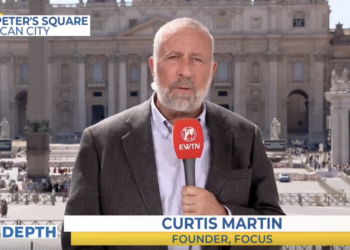Former White House advisor Steve Bannon predicted on Friday that President Donald Trump’s tariff strategy will generate up to $6 trillion in revenue over the next decade.
Trump threatened to impose a 25% tariff on tech giant Apple if iPhones sold in the U.S. aren’t manufactured domestically, urging CEO Tim Cook to move production from India and other countries. Bannon pointed to such proposals in Friday’s “War Room” episode, arguing such tariffs could generate trillions in revenue and revive Trump’s pre-pandemic growth model.
“Everybody’s going off the Congressional Budget Office numbers, particularly these very large deficits in the first couple years. They’re not taking in cash flow coming from tariffs that Peter Navarro and others are saying it’s $6 trillion over 10 years,” Bannon explained. “So that would equate to, I don’t know, $500 or $600 billion a year annually. Minimum people are talking about $300 billion in tariffs not being calculated. I think the White House is getting much more aggressive in talking about their model and the growth rates.”
Bannon tied the forecast to a broader resurgence in Trump’s first-term economic principles, particularly energy policy.
WATCH:
“And this is why we had Dave Walsh on this morning about how energy underpins President Trump’s economy, his economic model, just like in the first term, where he brought down energy costs and full spectrum energy dominance,” Bannon continued.
Bannon reminded viewers that by late 2019, the U.S. economy was expanding.
“And that drove the economy after the tax cuts into [20]18 and [20]19. And remember, [20]19, by the second half of the year before the pandemic, the COVID virus was released by the Chinese Communist Party, growth, I think, in the fourth quarter was 3%, 3.5%,” Bannon noted.
Despite headwinds from the Federal Reserve tightening monetary policy during that period, Bannon said that Trump still delivered growth without inflation.
“And he did that as they keep reiterating with the Federal Reserve really taking a trillion dollars of liquidity off their balance sheet and giving much more headwinds to the economy at the time. He had no inflation,” Bannon added.
President Trump announced reciprocal tariffs in April, raising rates above the 10% baseline for nations such as China that maintain steep trade barriers against the United States. Following his declaration of “Liberation Day,” Trump temporarily paused most tariffs for 90 days, excluding those targeting China, to allow room for negotiations with other nations.
Tensions with China escalated as the U.S. imposed a 145% tariff on the country, officially kicking off trade talks on May 10. In addition to tariffs, Trump also traveled to the Middle East, where he secured a $600 billion investment agreement with Saudi Arabia and locked in over $3 trillion in new commitments from the United Arab Emirates.
All republished articles must include our logo, our reporter’s byline and their DCNF affiliation. For any questions about our guidelines or partnering with us, please contact [email protected].
DONATE TO BIZPAC REVIEW
Please help us! If you are fed up with letting radical big tech execs, phony fact-checkers, tyrannical liberals and a lying mainstream media have unprecedented power over your news please consider making a donation to BPR to help us fight them. Now is the time. Truth has never been more critical!
Success! Thank you for donating. Please share BPR content to help combat the lies.
We have no tolerance for comments containing violence, racism, profanity, vulgarity, doxing, or discourteous behavior. Thank you for partnering with us to maintain fruitful conversation.





![CNN’s Jennings Roasts Biden's 'The View' Interview Defenders, Calls Out Coming Meltdown [WATCH]](https://www.right2024.com/wp-content/uploads/2025/04/Scott-Jennings-Wrecks-Former-Hillary-Spokesperson-with-One-Question-on-350x250.jpg)
![Frontier Airline Agents Fired After Video Mocking Passenger on Camera Goes Viral [WATCH]](https://www.right2024.com/wp-content/uploads/2025/05/Frontier-Airline-Agents-Fired-After-Video-Mocking-Passenger-on-Camera-350x250.jpg)

![Stephen A. Smith Goes Ballistic on DeMS-13 Senator Van Hollen [WATCH]](https://www.right2024.com/wp-content/uploads/2025/05/Stephen-A-Smith-Goes-Ballistic-on-DeMS-13-Senator-Van-Hollen-350x250.jpg)

![Dem Rep Caught on Bodycam Physically Attacking Law Enforcement at ICE Detention Facility [WATCH]](https://www.right2024.com/wp-content/uploads/2025/05/Dem-Rep-Caught-on-Bodycam-Physically-Attacking-Law-Enforcement-at-350x250.jpg)
![Minnesota Officials Panicking Over Derek Chauvin Pardon Speculation, Potential Unrest [WATCH]](https://www.right2024.com/wp-content/uploads/2025/05/Minnesota-Officials-Panicking-Over-Derek-Chauvin-Pardon-Speculation-Potential-Unrest-350x250.jpg)





